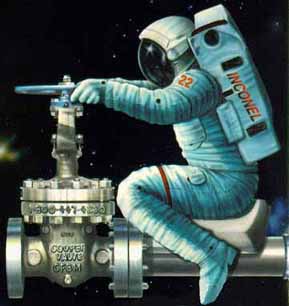

| Type of Steel | % Nickel | % Chromiium | % Carbon | % Manganese | % Silicon | % Nitrogen | Corrosion mpy (1) | Melting Range °F | Young's Modulus x 10^6,psi |
| 201 | 3.5 - 5.5 | 16.0 - 18.0 | 0.15 max | 5.5 - 7.5 | 1.0 max | 0.25 max | 20 | 2550 - 2650 | 28.0 |
| 301 | 6.0 - 8.0 | 16.0 - 18.0 | 0.15 max | 2.0 max | 1.0 max | 0 | 12 | 2550 - 2590 | 28.0 |
| 302 | 8.0 - 10.0 | 17.0 - 19.0 | 0.15 max | 2.0 max | 1.0 max | 0 | 10 - 18 | 2550 - 2590 | 28.0 |
| 304 | 8.0 - 10.5 | 18.0 - 20.0 | 0.08 max | 2.0 max | 1.0 max | 0 | 6 - 12 | 2550 - 2650 | 28.0 |
| 309 | 19.0 - 22.0 | 24.0 - 26.0 | 0.2 max | 2.0 max | 1.0 max | 0 | 5 - 9 | 2550 - 2650 | 29.0 |
(2) Table references
| Type | % Ni | % Cr | % C | % Mn | % Si | % Fe | % S | % Cu | % Al | % Ti | % P | % Co | % Nb | % B | % Mo |
| 600 | 72.0 min | 14.0 - 17.0 | 0.15 max | 1.0 max | 0.5 max | 6.0 - 10.0 | .015 max | 0.5 max | 0 | 0 | 0 | 0 | 0 | 0 | 0 |
| 601 | 58.0 - 63.0 | 21.0 - 25.0 | 0.1 max | 1.0 max | 0.5 max | bal | .015 max | 1.0 max | 1.0 - 1.7 | 0 | 0 | 0 | 0 | 0 | 0 |
| 625 | 58.0 min | 20.0 - 23.0 | 0.1 max | 0.5 max | 0.5 max | 5.0 max | 0.015 max | 0 | 0.4 max | 0.4 max | .015 max | 1.0 max | 3.15 - 4.15 | 0 | 8.0 - 10.0 |
| 718 | 50.0 - 55.0 | 17.0 - 21.0 | 0.08 max | 0.35 max | 0.35 max | bal | .015 max | 0.3 max | 0.2 - 0.8 | 0.65 - 1.15 | .015 | 1.0 max | 4.75 - 5.5 | .006 max | 2.8 - 3.3 |
| 800 | 32.5 | 21.0 | 0.1 max | 0.8 max | .008 max | 46.0 | 0 | 0.4 | 0.4 | 0.4 | 0 | 0 | 0 | 0 | 0 |
(1) Table references
| Type | Yield Strength 70°F ksi | Melting Range °F | Rupture Strength; 100h at ____°F, ksi | |
| 600 | 41.3 | 2471 - 2579 | 1600, 5.3 | |
| 601 | 49.0 | 2471 - 2579 | 1600, 7.0 | |
| 625 | 71 | 2300 - 2435 | 1600, 10.5 | |
| 718 | 172 | 2300 - 2435 | 1200, 100 | |
| 800 | 36.3 | 2471 - 2525 | 1800, 21 |
(1) Table references
http://www.eng.vt.edu/eng/materials/classes/MSE2094_NoteBook/
96ClassProj/examples/nicrfe.html